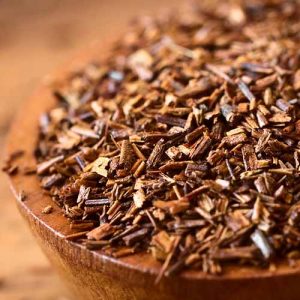
More evidence that low-calorie sweeteners are bad for your health
Studies show that artificial sweeteners can raise the risk of hypertension, metabolic syndrome, type 2 diabetes and heart disease, including stroke.

It is the restorative drink of choice for Precious Ramotswe, the heroine of Alexander McCall Smith’s novels about life at The No. 1 Ladies’ Detective Agency. But rooibos (or red bush) tea is more than just a nice drink.
Rooibos (pronounced roy-boss) is Afrikaans for Red Bush, and refers to the native South African plant Aspalanthus linearis.
Since the rooibos plant is actually a member of the legume family (the flowering plant family which also include beans and peas), it has quite a different profile to conventional black or green teas, which are made from the leaves of the camellia bush (part of the Theaceaefamily of trees and shrubs). Rooibos has an extremely high content of anti-oxidants, no caffeine and low tannin levels.
Perfectly adapted
Rooibos only grows in small area 250km north of Cape Town in the Cedarberg region of South Africa, in the Western Cape province.
The Cedarberg region has very little rainfall, and a sandy, very acidic soil with virtually no nitrogen. Rooibos has evolved to be perfectly suited to the ecosystem, and thrives without needing fertilisers – this allows for successful low tech farming and gives a livelihood to local people.
Part of the secret lies in the plant’s very long taproot, which can reach up to two metres into the ground. This means the plant can reach deep down into the soil for water, and so can withstand very dry conditions.
As a legume, the rooibos plant can also bind its own nitrogen through bacteria on its roots which take nitrogen from the air and ‘fix’ it in the plant. This means that rooibos needs no irrigation or fertilisation, and so grows and is harvested today much as it always been.
From green to red
The plant is harvested annually, with the green leaves being cut and collected into bundles. These are then taken to a processing yard were they are fed into a simple cutting machine and bruised with rollers. The plant material is then left in low heaps for the oxidation process to take place.
It’s not until the plant is processed that the reason for its name becomes apparent – once the green needle like leaves are cut and left to dry in the sun, they turn a beautiful bright mahogany red.
The early cultivators found seed collection challenging because the seed is “shot” out of the plant when ripe. Each plant produced only one seed so catching the seed is difficult. But as research improved collection methods improved. It was also discovered that ants collected the seeds and that by digging up the ant holes, the seeds could be easily collected.
A traditional remedy
Rooibos tea was traditionally used by the local Khoisan tribe as an herbal medicine for a wide range of ailments. Through the 17th and 18th centuries, European travellers and botanists began visiting the Cedar Mountains. Swedish botanist, Carl Thunberg, reported on its native use and it was adopted by the Dutch settlers to the Cape as an alternative to black tea, which was an expensive commodity brought on supply ships from Europe.
Its worldwide popularity began in 1904, when Russian immigrant Benjamin Ginsberg saw a marketing potential and began to export, calling it ‘Mountain Tea’. Farmers then began to cultivate the crop on a wider scale as demand grew, especially in the West during World War II, when the supply of traditional Asian black tea was scarce.
A modern success story
In 1974, a South African mother named Annique Theron published a book on the benefits of rooibos in skincare and its use for children called Allergies: an Amazing Discovery, and later created a successful range of rooibos based skincare products.
In 1997, the World Intellectual Property Organisation (WIPO) awarded rooibos a gold medal for its anti-allergic properties, and in 1998 it awarded Annique Theron ‘Woman Discoverer of the Year’.
Today 13,000 hectares of land are under cultivation to grow rooibos, yielding around 8,000 tonnes annually. About half is drunk in South Africa and the rest exported mostly to Germany, Japan and the Netherlands and the UK.
Health benefits inside and out
Rooibos is used to treat a wide range of symptoms ranging from headaches, colic, asthma, hay fever and insomnia. It is also said to be beneficial to pancreatitis sufferers, as it soothes the pain of digestive reflux.
Due to its high content of the anti-inflammatory antioxidant quercetin, which has been shown in clinical trials to relieve the symptoms of prostatitis, it is used to ease the painful symptoms of urinary system diseases such as prostatitis and cystitis.
Rooibos is also excellent for treating skin conditions such as eczema, psoriasis or dermatitis. It soothes nappy rash and improves skin condition in acne sufferers.
Hospitals in South Africa routinely use rooibos in baths for children with allergic skin conditions, as well as giving it as a drink. The infusion can either be applied to the skin, used as a wash to relive dry, itchy scalp, or used in skincare products such as soaps and cleansers.

Please subscribe me to your newsletter mailing list. I have read the
privacy statement